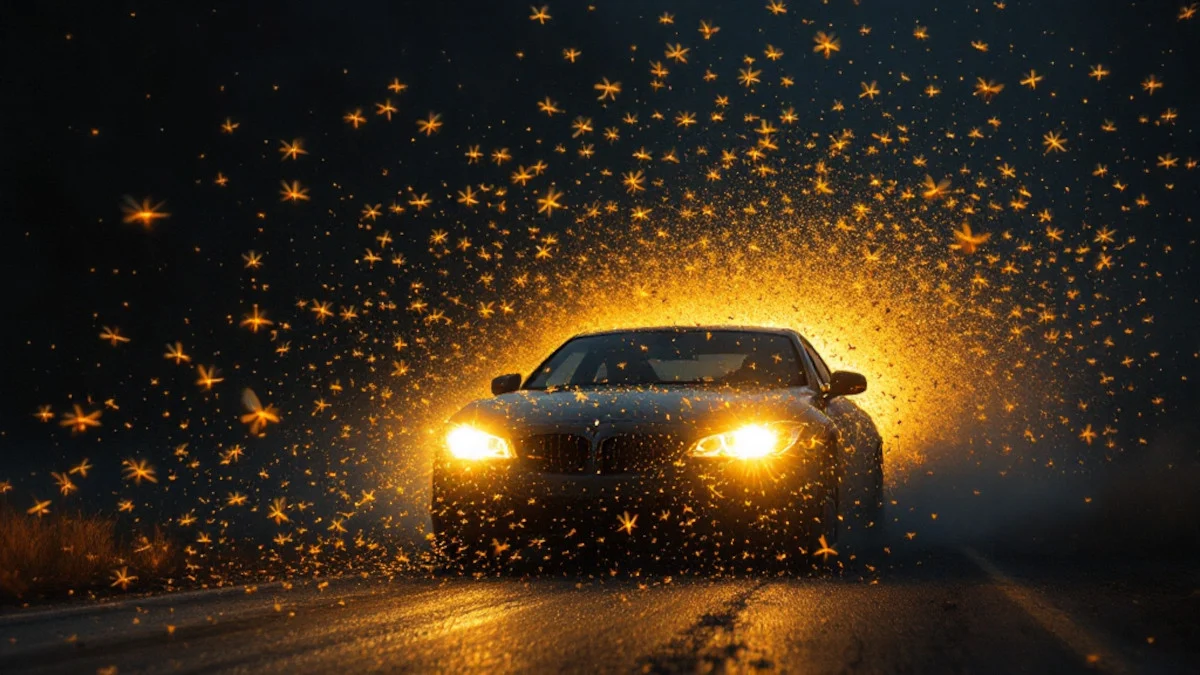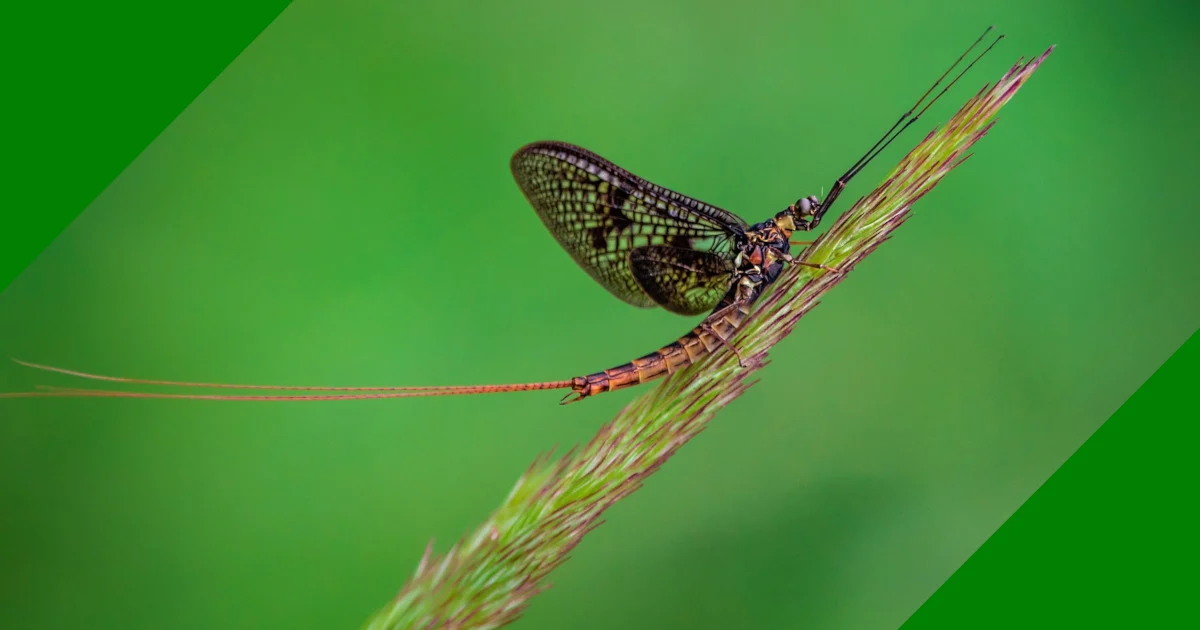
Ever wonder what the little bugs that fly around lights at night are? Discover why mayflies swarm around lamps, their role in nature, and simple ways to deal with them.
Table of Contents
What Are the Little Bugs That Fly Around Lights at Night?
If you’ve traveled near rivers or lakes on warm evenings, you’ve probably seen clouds of tiny insects circling around street lamps or porch lights. These are often mayflies—delicate, short-lived insects that appear in massive swarms, especially during their mating season.

Mayflies belong to one of the oldest groups of winged insects, with a lineage stretching back over 300 million years. Despite their fragile appearance and brief adult lifespan—sometimes only a single day—mayflies play a vital role in freshwater ecosystems and food chains.
Life Cycle of Mayflies and the Food Chain
During their nymph stage, which can last months or even years, they live on the bottom of rivers and lakes, feeding on algae and organic debris. This activity helps recycle nutrients and maintain water clarity because the algae are prevented from growing too thick that would prevent light from reaching the bottom the lake. The herbivory process also prevents the deposition of too much organic matter due to freshwater plant uptake, thereby removing nutrients for photosynthesis. In turn, mayfly nymphs are a critical food source for fish such as trout and bass, as well as for amphibians and aquatic birds.
When they emerge in massive swarms as adults, they provide an abundant seasonal feast for bats, birds, and other predators, transferring energy from aquatic to terrestrial ecosystems. The return of nutrients due to siltation or natural runoff in lakes is made possible by the occasional swarms of mayflies over land. Mayflies serve as vectors of nutrient dissemination or distribution not only in their habitat but also in upland ecosystems.

Because mayflies are highly sensitive to water pollution, their presence is also a reliable sign of clean, healthy water (Benhadji et al., 2025). They die when there is too much input of toxic substances into the water. In this way, mayflies act as both ecosystem engineers and ecological indicators, supporting biodiversity while reflecting the health of freshwater habitats.
Mayflies belong to the ancient insect order Ephemeroptera, with over 3,000 known species globally. Their immature stage—nymphs—lives underwater for anything from weeks to years before emerging as short-lived winged adults (Barber-James et al., 2008). The word “Ephemeroptera” reflects their brief adult life, often just a few hours to a couple of days.
Why Do Mayflies Swarm Around Lights?
The little bugs that fly around lights are strongly attracted to brightness due to a behavior called positive phototaxis. Positive phototaxis is the movement of an organism toward a light source that allow it to find food or its mate. Mayflies use the moon and stars to orient themselves during their brief search for mates (Eklöf, 2023). Artificial lights, however, confuse them, drawing thousands into circling swarms.
Their appearance is also tied to synchronized hatching events. When conditions like temperature and humidity align, thousands of mayflies emerge at once (Brittain,1982). This sudden mass flight often coincides with evenings, making lights irresistible gathering points.
Why Mayflies Matter
Although they can seem like a nuisance, mayflies are actually signs of a healthy environment:
- Clean water indicators: Their nymphs live in rivers and lakes, and their presence means the water is not polluted.
- Essential food source: Fish, birds, and bats depend on them during hatching season.
- Ecosystem recyclers: When they die, their bodies enrich the environment with nutrients.
Mayfly swarms can even be so large that they show up on weather radar—a natural spectacle that highlights their abundance.
How to Deal With Mayflies Around Lights
If you encounter mayflies while traveling or at home near water, there are simple and humane ways to manage them:
- Turn off unnecessary lights at night during swarming season.
- Use yellow or warm-toned bulbs (“bug lights”), which are less attractive to insects.
- Seal windows and doors to keep them from entering indoor spaces.
- Create airflow with fans on patios or porches to help disperse swarms.
- Attach plastic sando bags near your lamps using a masking tape to trap mayflies that happen to enter your home. Their random flying will land them eventually inside the bags. Dispose them afterwards to your plants to serve as nutrients.
It’s important to remember that mayflies don’t bite, sting, or carry disease. They are harmless, if sometimes overwhelming, companions on summer nights.
Interesting Facts About Mayflies
- Some species live less than 24 hours as adults, giving them the nickname “one-day insects.”
- Their mass flights often look like clouds of “dancing dust.”
- Swarms can emit a distinct earthy odor from pheromones released during mating.
- Scientists often study mayflies to monitor water quality in rivers and lakes.
Now You Know Better About Mayflies
So, the next time you ask yourself, “What are the little bugs that fly around lights at night?”—remember that they are often mayflies (while it’s possible that they may be moths like the ones you find in your ceiling lamp), remarkable insects whose brief lives support entire ecosystems.
Far from being just a travel nuisance, these swarms are reminders of clean rivers, thriving wildlife, and the fleeting beauty of nature. They are nature’s reminders of clean water, biodiversity, and the fleeting beauty of life itself.
The areas usually affected by swarms of mayflies are in or around large bodies of freshwater like clean lakes, rivers, and streams. They’re a most welcome sight telling you that the source of freshwater fish that you eat nearby is clean and healthy.
FAQ
1. What are the little bugs that fly around lights at night?
They are typically mayflies, small aquatic insects in their adult phase, drawn to light as part of their swarming behavior.
2. Why do mayflies swarm around lights?
They exhibit positive phototaxis—a natural attraction to light that misdirects them when artificial lighting replaces natural cues.
3. Are mayflies harmful to humans?
Not at all—they don’t bite, sting, or eat. Their short-lived adult life is focused solely on mating.
4. How can I minimize mayfly swarms at night?
Use yellow-toned “bug lights,” turn off outdoor lights when possible, and keep windows and doors properly sealed.
5. Do mayfly swarms indicate anything special?
Yes. Large swarms suggest clean water and healthy ecosystems. However, declining numbers may signal environmental stress.
Sources of Information
Articles/Books
Barber-James, H. M., Gattolliat, J. L., Sartori, M., & Hubbard, M. D. (2008). Global diversity of mayflies (Ephemeroptera, Insecta) in freshwater. Hydrobiologia, 595(1), 339-350.
Bauernfeind, E., & Soldan, T. (2013). The Mayflies of Europe (Ephemeroptera). Brill.
Benhadji, N., Kurniawan, S. B., & Imron, M. F. (2025). Review of mayflies (Insecta Ephemeroptera) as a bioindicator of heavy metals and microplastics in freshwater. Science of the Total Environment, 958, 178057.
Brittain, J. E. (1982). Biology of mayflies. Annual Review of Entomology, 27(1), 119-147.
Corkum, L.D., Ciborowski, J. J. H., and Dolan, D. M. 2006. Timing of Hexagenia (Ephemeridae: Ephemeroptera) mayfly swarms: Canadian Journal of Zoology v. 84 n. 11, pg. 1616-1622.
Eklöf, J. (2023). The darkness manifesto: On light pollution, night ecology, and the ancient rhythms that sustain life. Simon and Schuster.
Blog
Michigan Sea Grant (2024). When will the mayflies arrive? Retrieved on August 20, 2025 from https://www.michiganseagrant.org/blog/2024/03/11/when-will-the-mayflies-arrive/


